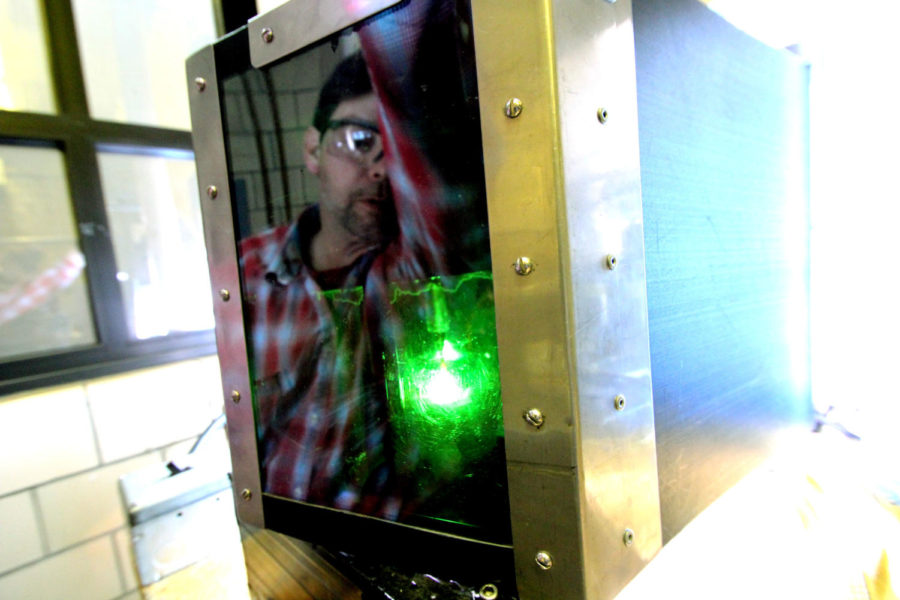Rare earth research pulls in part of $120 million grant
photo: Jonathan Krueger/Iowa State Daily
Steve Medeiros, associate scientist at the U.S. Department of Energy Ames Laboratory, uses an arc melter, which pours energy equivalent to a lighting bolt into a rare earth sample Jan. 11, 2013. The light produced by this process is so bright it can blind a person, so a shield is required.
January 14, 2013
In an age where cell phones, car radios and fluorescent lighting reign supreme, the world starts to look a bit bare without the aid of rare earth materials to build many modern technologies.
“You wouldn’t have very much of anything,” said Alex King, director of U.S. Department of Energy Ames Laboratory.
King received a phone call on Tuesday informing him that Ames Laboratory had received part of a $120 million grant over a period of five years to fund the hiring of 60 personnel and purchasing of equipment to advance research in the area of rare earth materials.
The grant is part of the U.S. Department of Energy Hubs, or a large series of projects to ensure sustainable energy in the future, announced to the public on Wednesday.
The funding will add an additional 20 percent to U.S. Department of Energy Ames Laboratory’s $40 million annual budget, with King estimating receiving about $8 million a year over the five-year period. With the funding of the Critical Materials Institute, a virtual institute collaborating between several national labs and universities, King is hoping to have an impact on the rare earths industry, saying the institute will be “ready to hit the ground running on day one.”
“We’ve always done rare earth research at Ames Lab; we’re kind of rare earths central for the [United States] if not the world,” King said. “All the best rare earth specimens come from the Ames Lab; we purify them better than anybody else.”
The opportunity to gain federal money for rare earth research had been on King’s radar for two years. When the U.S. Department of Energy formally gave the funding opportunity announcement last spring, Ames Laboratory staff pulled together a 1,600-page proposal within a period of 90 days.
Bill McCallum, senior material scientist at U.S. Department of Energy Ames Laboratory and co-principal investigator of the grant, anticipated the funding announcement in a few more months.
“I didn’t expect to hear the announcement for quite some time yet,” McCallum said. “It was very pleasing and very surprising when we got the announcement.”
After the paperwork is filed, Ames Laboratory will begin the arduous task of what King describes as “starting up a $25 million dollar a year business from scratch.”
Nearly as important as hiring personnel is the purchasing and upgrading of research equipment. Brandt Jensen, assistant scientist at Ames Laboratory, stresses the importance of finding the right balance of materials to create rare earth products.
“The basic form of the magnet is three metals, so we have to carefully weigh them in the right ratio,” Jensen said. “It’s a long process. To get a magnet you first have to melt them all together … but it’s not complete yet, the atoms aren’t in the right location on the atomic level.”
In order to create a rare earth magnet to fit in a simple earphone, the magnet needs to go through several processes and characterizations to make sure it is just right.
Producing alternatives to and conservative use of rare earth materials is just one side of Ames Laboratory’s research. A new field called the economic forecasting and life cycle management of materials will give a holistic view of how different materials are being used and when scientists can start expecting those materials to be scarce.
“What we’re looking for is trying to understand the supply and demand dynamics of the rare earths … but also using the economic analysis to try and predict what other materials are going to go critical suddenly without our being ready for it,” King said. “Today we’re dealing with the rare earths; tomorrow we’ll be dealing with something else.”
The economic analysis will take into account the political atmosphere in which materials are being produced in addition to predicting which areas are more at risk for large scale natural disasters.
Although he hasn’t had much time to himself since the announcement, King is enjoying the atmosphere of excitement that has overtaken the Ames Laboratory staff.
“We were all very excited,” Jensen said. “There’s going to be a lot more research opportunity, there’s going to be staff we train with, it’s going to open up a lot of doors.”

















